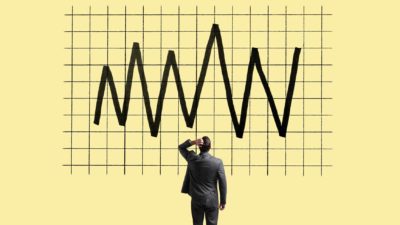I have a question for you.
Would you rather a certain $500,000, or a 50:50 shot at ending up with $700,000, but getting only $200,000 if things don't work out?
I can tell you what the maths suggests: a 50:50 chance of either $700,000 or $200,000 gives an expected value of $450,000 (50% of 700k + 50% of 200k).
A certain $500,000 is, well, still $500,000. It's the better bet, statistically speaking.
But why do I ask?
Because that very question – explicit and implicit – is being asked and answered by investors, every day.
Some have the conversation with their financial planner, assessing their tolerance for risk, and selecting an investment strategy accordingly.
Some think it through themselves, and the answer is shown in what psychologists call their 'revealed preferences' – how they actually invest.
And some answered a Twitter poll, posted by our US sister organisation. The question posed was 'What matters more to you in stock investing?'.
The options:
1. Avoiding big losers
2. Finding big winners
And the results?
50:50.
Well, 49.9% and 50.1%, respectively… but I'll call that a tie.
Now, Twitter polls aren't scientific etc. And yet, that very poetic 50:50 split illustrates the issue beautifully.
See, when someone asks me, at a barbecue, on telly, or in an Uber 'What stocks should I buy?', the real answer is always 'it depends'.
It depends on your answer to the above question.
And a whole lot of other things!
But – and let me dig a little deeper here – I'm not even sure those people answering the poll really, truly, know themselves, necessarily.
How many investors, in 2021, were in the 'Finding big winners' camp, but are now chastened by the big tech company share price falls of 2022 and 2023 and are now in the 'Avoiding big losers' group?
How many investors, who consider themselves in the 'Avoiding big losers' camp, will start swinging for the fences, once their brothers-in-law start getting rich on some speculative mining stocks?
Or who will play it safe for a while, only to realise they won't have as much as they'd like in retirement, and start to try to play 'catch up', taking greater and greater risks – knowingly or otherwise?
And – and let me put my investment advisor's hat on here for a sec – how many of both groups are making decisions without a good understanding of themselves, of the maths, and of the markets?
You've probably heard the Mike Tyson line that 'everyone has a plan until they're punched in the face'. That can be true of investing. It can be very easy to lose your nerve when markets go south.
See pain – emotional and otherwise – is hard to endure. And people will do what they can to avoid it. It's where the phrase 'to cut your losses' comes from. The key thought? Just. Make. It. Stop.
Now, Tyson more than anyone, understands 'no pain, no gain'. (Well, Evander Hollyfield probably understands it better, after Tyson bit off part of his ear, but I digress.)
So what should an investor do? Well, there is one good option, one okay option, and one bad option.
The good option is to have planned for down markets, to have steeled yourself for them, and to have prepared your portfolio for them. To own companies that are long term winners, even if you have to endure some paper losses along the way.
The okay option? If you can't do the above, don't do it at all. Because…
The bad option is investing during the good times, then selling, at a loss, in the bad times because you can't take it any more… crystallising a permanent capital loss.
Because it's easy for me to say 'I reckon you should buy shares in Company X, because over the next decade, I think it'll do really well'.
It's harder for some people (perhaps those 50% who wanted to avoid big losers) to keep the faith, if that company's shares fall 30%, 40% or more half a dozen times along the journey, even if I'm right in the end.
And if they're going to sell at the first sign of trouble, they're better not buying those shares at all, because they won't be around to share in the eventual spoils.
I've often talked about Amazon's extraordinary rise, both as a business, and as a stock. (I own shares, for the record).
Those shares, up 129,000% (unfortunately, I was late to this particular party!) since listing, have nonetheless fallen – hard – many, many times.
Worth holding, regardless? You bet.
But you had to do just that… hold.
Too many people didn't. Couldn't.
They get no criticism from me. But I wish they'd have known that about themselves, up front, rather than buying, then selling for a loss, and wondering what might have been.
See, I want everyone to invest. I've seen – from history and with my own eyes – just how remarkable long-term compounding can be.
But I don't want people to invest unless and until they've made their peace with what to expect from the stock market.
If you haven't, or can't, I reckon you're better off not investing at all.
But I hope you can find a way to make your peace with it.
To know what to expect. And to commit yourself to seeing it through anyway; accepting the lumps and bumps because the outcomes are worth the pain.
You don't have to be Mike Tyson.
But you do have to make sure you're still in the proverbial ring at the end of the bout.
You don't have to love the pain.
You don't have to enjoy falling share prices.
But you do have to commit to staying the course.
How you do that is up to you.
Maybe you make yourself a student of financial history, learning about both the historical volatility and the enormous historical returns, despite that volatility.
Maybe you use a financial planner as your financial coach.
Maybe you build your portfolio using one of our investment services (or one of our – reputable – competitors) where you can lean on the analysis and experience of others.
Maybe you simply decide it's not for you.
All of those are valid options.
And each is better than jumping in and out of the market, locking in losses each time, and swearing off investing.
Because forewarned is, as they say, forearmed.
There is going to be volatility.
There are going to be losses.
There are going to be times when you just want the pain to stop.
And yet, history tells us that, over the long term, a suitably diversified portfolio has delivered extraordinary gains.
I can't promise that'll continue. No-one knows the future.
But I can tell you that I expect to be fully invested – and adding more to my portfolio – for decades and decades to come.
My suggestion?
Why not re-read the above. Work out what sort of investor you are, and what you need to do to make sure you can stay the course.
Because, financially, nothing substitutes for making sure you're still there at the end.
Fool on!









